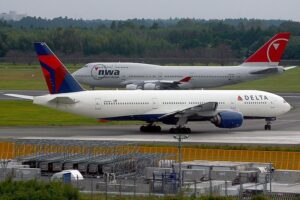
A Delta Airlines Boeing 777-200ER at Tokyo Narita Airport.
Photo Credit: Konstantin Von Wedelstaedt (http://tinyurl.com/4e5fbkxp)
Flight Emergency: What are the pilot’s actions when an engine fails in flight?
An engine failure on a twin-engine plane is very rare, yet it remains one of the most extensively trained and tested exercises in a pilot’s career.
Engine failures during take-off are simulated more frequently than those during cruising due to the heightened risk inherent in this phase of flight.
Handling protocols vary slightly depending on whether the incident occurs on a domestic or international long-haul flight.
Typically, in the event of an engine failure, a pilot’s course of action is clear: adhere to the day’s Golden Rules – aviate, navigate and communicate.
Firstly, the pilot must “aviate”, ensuring the stricken aircraft remains under control.
Subsequently, he must “navigate” and considers a return to the departure airport or divert to the nearest airport, especially if the failure occurs during the cruise phase.
Finally, the captain must “communicate” to keep relevant personnel informed.
To aid pilots’ recall, they act on the 5 C’s (CCCCC):
Crew: Inform all cockpit crew members.
Controller: Communicate with air traffic control and declare a distress call.
Cabin Crew: Inform the cabin crew of the nature of the emergency, whether an evacuation was required; time to impact or any special instructions.
Customers: Keep all passengers updated.
Company: Notify flight operations.
Once all relevant parties are informed, the captain prepares and briefs the crew for the landing.
During a long-haul flight, the captain may need to jettison excess fuel to ensure it complies with the maximum landing weight.
A notable incident occurred on January 14, 2020, involving a Delta Airlines Boeing 777 departing from Los Angeles and bound for Shanghai. The aircraft experienced a compressor stall leading to an engine failure shortly after take-off. The captain opted to return to the Los Angeles International Airport.
Normally, the captain would notify air traffic control of the need to dump fuel and controllers would direct the plane to an appropriate fuel-dumping area.
I recall an incident from Stockholm to Kuala Lumpur on a Boeing 777 where I had to dump fuel due to a pressurization problem, I was directed to a designated airspace over the Baltic Sea to jettison 80 tonnes of fuel at 8000 feet.
According to Boeing, fuel dumped at an altitude above 5,000 feet should vaporize before reaching the ground.
However, in the Delta Airlines flight, the fuel was let off at 2300 feet over populated areas, contrary to the normal procedure.
This decision led to outrage within the affected communities, as several students at an elementary school were inadvertently doused with fuel.
Thankfully, jet fuel, unlike gasoline, has a higher flash point, requiring high temperatures to ignite.
Imagine the potential consequences if sparks of fire were present!
View a YouTube video ‘Bursting into Flames Immediately After Take-off from Los Angeles’